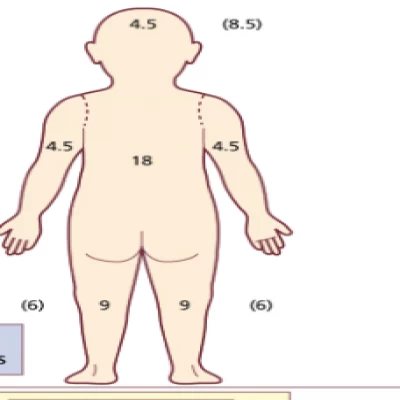مجلات علمية

Atopic dermatitis is a worldwide inflammatory disease and Scorad is a tool to determine its severity. Eczema is a chronic disease, there is no cure for AD,
the symptoms will go and come again, and all the drugs are used to relieve the uncomfortable symptoms.
It can lead to other atopic comorbidities.
What does SCORAD mean?
"SCORAD" stands for "scoring atopic dermatitis", it's a common measurement scale that determines the severity of AD and whether the treatment is effective or not before and during the therapy.
It was developed by ETFAD [European Task Force on atopic dermatitis]in 1993, ETFAD is a group of dermatologists who have worked hard to make a severity score system of AD in the 1990s.
What is the aim of proposing SCORAD?
1)There are different severity stages of AD and every stage requires a specific course of treatment and there is no specific diagnostic test to determine the severity of AD.
So clinical and dermatologists depend on SCORAD and other scales to access the most suitable medication for each patient.
2)Clinical trials rely on it in their outcome measures.
3)For example,If you have extensive skin lesions which make you unable to do your work or have suffered from eczema for a long time and your body doesn't respond to the treatment, Sometimes the government may need documents to evaluate the severity of your condition, and consequently, the Social Security Administration will decide whether to put your name in the disability listing or not.
How is SCORAD calculated?
scorad is the most validated, reliable scoring system in atopic dermatitis. It is a composite scoring system that combines objective measurements ( extent and intensity of disease) and subjective measurements( pruritus and sleep loss).
It is calculated from the formula A/5+7B/2+C
The subjective measurements:
"A" refers to the extent of AD and which means the determination of the affected area by eczema on your skin all over the body by using n
rule of nine (which divides the total body area into percentages):
•The front and the back of each arm equal 9% if the front is the only affected area in the arm then it will equal 4.5%
•Lower limbs each one equal 18%
•Front and back of Head and neck equal 9%
•Anterior trunk equal 18%
•Posterior equal 18%
•genitals equal 1%
"A" is calculated after drawing the affected lesion on the evaluation form and its range of "A" is from (0 to 100).
"B " refers to the intensity of six items and it is measured by grading each item on a scale from 0 /1/2/3 (No/mild moderate severe and add the scores of each item together to get the intensity:
1)Erythema (Redness)
2) Oedema(Swelling)
3)Oozing (crusts)
4)Excoriation
5)Lichenification
6)Dryness(at the area that is unaffected only)
The objective measurements :
pruritus[itching] and sleep loss ( over the last three days )are scored by visual analog scale from 0 to 10 and asking the patient to point at the number which expresses how to extend his sleep loss and pruritus are worse, then the two scores will be added to calculate "C", the range of "C" is from 0 to 20.
Then doctors calculate the SCORAD from the formula
The SCORAD index range's [ 0 -103] and based on the SCORAD index results, Atopic eczema has been classified into mild (< 25), moderate (25–50), and severe (> 50).
The patient tool PO_SCORAD :
Most drugs for eczema are topical drugs so the treatment success depends on the regularity and correct use of the patient.
Therefore the ETFAD in 2011 developed the PO-SCORAD [Patient-Oriented Scoring Atopic Dermatitis] a self-assessment scoring system derived from the SCORAD index.
It is easy to use which doesn't require a specific level of education to use, enables patients to better understand their disease, makes them more independent and more aware of the importance of visiting their doctors regularly, and using the treatment correctly.
By facilitating the ability of patients to evaluate the degree of danger of their eczema, assessing the progress of eczema and the efficacy of the treatment, allows you to compare your state in the different visits to your doctor, you can add comments, photos and share your results with your doctor.
PO-SCORAD validity study:
A large group of AD patients [different ages, children, and adults] from 9 European countries who have different stages of eczema [mild, moderate, and severe] participated in tests to measure the validity of PO-SCORAD.
They stayed at hospitals and used PO-SCORAD to monitor changes in their AD, the doctor also used Scoring atopic dermatitis to measure the AD development, and the results were compared over 28 days from entering the hospital.
There was a very good correlation between the two scoring systems and the results were very similar in adult and children groups and thus confirms that PO-SCORAD is a valuable and valid tool.
Eczema Area And Severity Index:
EASI is another scoring tool developed in 1998 to measure the extent and AD severity.
It's calculated from the severity score of the only affected area and the area score of four body regions.
1)severity score:
It's included assigning the intensity of four signs in the eczema area:
1)Redness
2)Thickness
3)Scratching
4)lichenification
If the sign intensity is mild, moderate, severe then the score is (1,2,3) respectively, the score will be zero if the sign is absent.
Severity score= intensity of (Redness+Thickness + Scratching +lichnetenich )
2)Area score:
Calculated by recording the percentage of eczema in four regions of the body :
1)Head and neck:
•Face =33‰for each side.
•Neck =33% (front and back)
•Scalp of neck and face=33‰
2)The trunk and genital area:
•Front =55%
•Back=45%
3)Upper limbs:
Each arm=50%(Front and back)
4)lower limbs
•Each leg =45%(Front and the back)
•Buttocks = 10%




